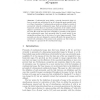89 search results - page 12 / 18 » Object oriented design pattern decay: a taxonomy |
CORR
2002
Springer
13 years 8 months ago
2002
Springer
for data abstraction and justifies reasoning by simulation. Representation independence has been shown for a variety of languages and constructs but not for shared references to mu...
ECOOP
2005
Springer
14 years 2 months ago
2005
Springer
The three problems of the title — the first two widely discussed in the literature, the third less well known but just as important for further development of object technology ...
GBRPR
2009
Springer
13 years 6 months ago
2009
Springer
Abstract. Combinatorial maps define a general framework which allows to encode any subdivision of an nD orientable quasi-manifold with or without boundaries. Combinatorial pyramids...
PPOPP
2003
ACM
14 years 1 months ago
2003
ACM
A design pattern is a mechanism for encapsulating the knowledge of experienced designers into a re-usable artifact. Parallel design patterns reflect commonly occurring parallel co...
ECOOP
2010
Springer
13 years 12 months ago
2010
Springer
Method overloading is a controversial language feature, especially in the context of Object Oriented languages, where its interaction with overriding may lead to confusing semantic...

